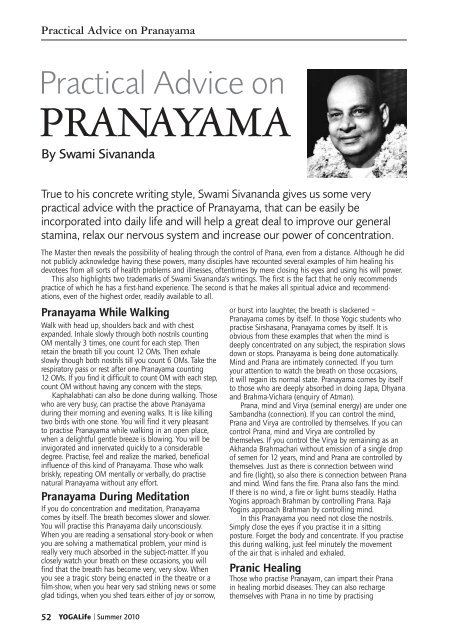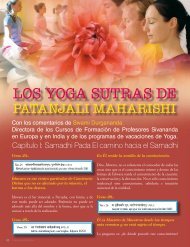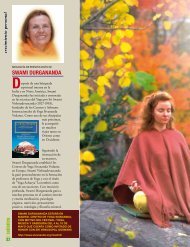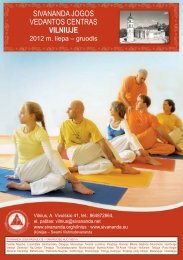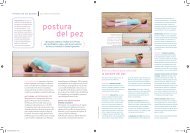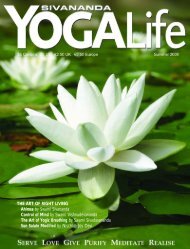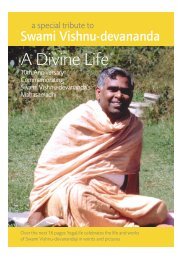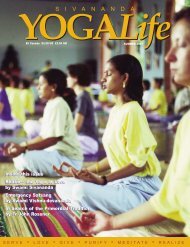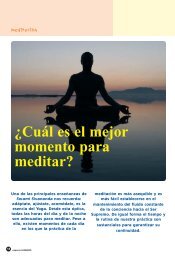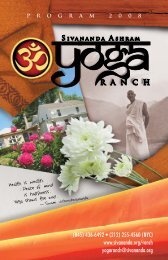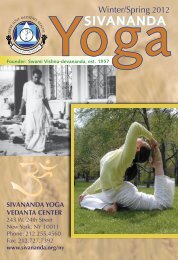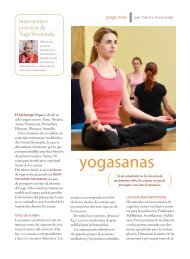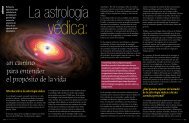YOGALife I Summer 2010 - Sivananda Yoga
YOGALife I Summer 2010 - Sivananda Yoga
YOGALife I Summer 2010 - Sivananda Yoga
You also want an ePaper? Increase the reach of your titles
YUMPU automatically turns print PDFs into web optimized ePapers that Google loves.
Practical Advice on Pranayama<br />
Practical Advice on<br />
PRANAYAMA<br />
By Swami <strong>Sivananda</strong><br />
True to his concrete writing style, Swami <strong>Sivananda</strong> gives us some very<br />
practical advice with the practice of Pranayama, that can be easily be<br />
incorporated into daily life and will help a great deal to improve our general<br />
stamina, relax our nervous system and increase our power of concentration.<br />
The Master then reveals the possibility of healing through the control of Prana, even from a distance. Although he did<br />
not publicly acknowledge having these powers, many disciples have recounted several examples of him healing his<br />
devotees from all sorts of health problems and illnesses, oftentimes by mere closing his eyes and using his will power.<br />
This also highlights two trademarks of Swami <strong>Sivananda</strong>’s writings. The first is the fact that he only recommends<br />
practice of which he has a first-hand experience. The second is that he makes all spiritual advice and recommend -<br />
ations, even of the highest order, readily available to all.<br />
Pranayama While Walking<br />
Walk with head up, shoulders back and with chest<br />
expanded. Inhale slowly through both nostrils counting<br />
OM mentally 3 times, one count for each step. Then<br />
retain the breath till you count 12 OMs. Then exhale<br />
slowly though both nostrils till you count 6 OMs. Take the<br />
respiratory pass or rest after one Pranayama counting<br />
12 OMs. If you find it difficult to count OM with each step,<br />
count OM without having any concern with the steps.<br />
Kaphalabhati can also be done during walking. Those<br />
who are very busy, can practise the above Pranayama<br />
during their morning and evening walks. It is like killing<br />
two birds with one stone. You will find it very pleasant<br />
to practise Pranayama while walking in an open place,<br />
when a delightful gentle breeze is blowing. You will be<br />
invigorated and innervated quickly to a considerable<br />
degree. Practise, feel and realize the marked, beneficial<br />
influence of this kind of Pranayama. Those who walk<br />
briskly, repeating OM mentally or verbally, do practise<br />
natural Pranayama without any effort.<br />
Pranayama During Meditation<br />
If you do concentration and meditation, Pranayama<br />
comes by itself. The breath becomes slower and slower.<br />
You will practise this Pranayama daily unconsciously.<br />
When you are reading a sensational story-book or when<br />
you are solving a mathematical problem, your mind is<br />
really very much absorbed in the subject-matter. If you<br />
closely watch your breath on these occasions, you will<br />
find that the breath has become very, very slow. When<br />
you see a tragic story being enacted in the theatre or a<br />
film-show, when you hear very sad striking news or some<br />
glad tidings, when you shed tears either of joy or sorrow,<br />
52<br />
<strong>YOGALife</strong> I <strong>Summer</strong> <strong>2010</strong><br />
or burst into laughter, the breath is slackened –<br />
Pranayama comes by itself. In those Yogic students who<br />
practise Sirshasana, Pranayama comes by itself. It is<br />
obvious from these examples that when the mind is<br />
deeply concentrated on any subject, the respiration slows<br />
down or stops. Pranayama is being done automatically.<br />
Mind and Prana are intimately connected. If you turn<br />
your attention to watch the breath on those occasions,<br />
it will regain its normal state. Pranayama comes by itself<br />
to those who are deeply absorbed in doing Japa, Dhyana<br />
and Brahma-Vichara (enquiry of Atman).<br />
Prana, mind and Virya (seminal energy) are under one<br />
Sambandha (connection). If you can control the mind,<br />
Prana and Virya are controlled by themselves. If you can<br />
control Prana, mind and Virya are controlled by<br />
themselves. If you control the Virya by remaining as an<br />
Akhanda Brahmachari without emission of a single drop<br />
of semen for 12 years, mind and Prana are controlled by<br />
themselves. Just as there is connection between wind<br />
and fire (light), so also there is connection between Prana<br />
and mind. Wind fans the fire. Prana also fans the mind.<br />
If there is no wind, a fire or light burns steadily. Hatha<br />
Yogins approach Brahman by controlling Prana. Raja<br />
Yogins approach Brahman by controlling mind.<br />
In this Pranayama you need not close the nostrils.<br />
Simply close the eyes if you practise it in a sitting<br />
posture. Forget the body and concentrate. If you practise<br />
this during walking, just feel minutely the movement<br />
of the air that is inhaled and exhaled.<br />
Pranic Healing<br />
Those who practise Pranayam, can impart their Prana<br />
in healing morbid diseases. They can also recharge<br />
themselves with Prana in no time by practising


